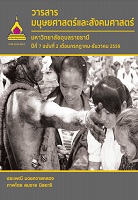การประเมินผลการดำเนินการของเครือข่ายบริการสุขภาพระดับอำเภอ กรณีอำเภอเดชอุดม จังหวัดอุบลราชธานี
Main Article Content
บทคัดย่อ
การวิจัยประเมินผลการดำเนินการของเครือข่ายบริการสุขภาพอำเภอ (District Health System: DHS) จังหวัดอุบลราชธานี รวบรวมข้อมูลทั้งเชิงปริมาณและเชิงคุณภาพ ตามกรอบของ CIPP Model เครื่องมือวิจัยคือ แบบสอบถามความพึงพอใจการดำเนินงานเครือข่ายสุขภาพระดับอำเภอ ของเจ้าหน้าที่ และผู้รับบริการ แบบสอบถามความพึงพอใจผู้รับบริการตามประเด็นสุขภาพที่เลือก แบบประเมินความก้าวหน้าการดำเนินงาน DHS และ แบบสัมภาษณ์กึ่งโครงสร้าง กลุ่มตัวอย่างประกอบด้วย ระดับจังหวัด 5 คน ระดับอำเภอ 8 คน และระดับตำบลจำนวน 20 คน รวบรวมข้อมูล ระหว่าง ธันวาคม 2557- มิถุนายน 2558 วิเคราะห์ข้อมูลเชิงพรรณนา โดยใช้ ร้อยละ ค่าเฉลี่ยและส่วนเบี่ยงเบนมาตรฐาน ข้อมูลเชิงคุณภาพใช้การวิเคราะห์เนื้อหา
ผลการวิจัย ด้านบริบท ภาพรวมอยู่ในระดับมาก ประกอบด้วย การกำหนดบทบาทหน้าที่ ด้านการทำงานร่วมกันในระดับอำเภอ การคัดเลือกปัญหา และพึงพอใจเฉลี่ยกับการ มีส่วนร่วมในการดำเนินงานในระดับมาก ด้านปัจจัยนำเข้า ความคิดเห็นของผู้ให้บริการ ด้าน บุคลากร มีความพึงพอใจเฉลี่ยอยู่ในระดับมาก ต่อแผนพัฒนาบุคลากร และวิธีการพัฒนา และการแบ่งบันทรัพยากร ในระดับปานกลางประกอบด้วย ด้านงบประมาณ ด้านวัสดุ อุปกรณ์ สื่อ ส่วนความคิดเห็นของผู้รับบริการ อยู่ในระดับมาก ในการให้คำแนะนำ ช่วยเหลือ ให้บริการของเจ้าหน้าที่ และงบประมาณ ข้อมูลเชิงคุณภาพพบว่า มีการใช้บุคลากร อุปกรณ์ สื่อร่วมกัน แต่บุคลากร และงบประมาณไม่เพียงพอ ด้านกระบวนการ ทุกข้ออยู่ในระดับมาก ความคิดเห็นของผู้ให้บริการและผู้รับบริการด้านที่มากที่สุด คือ การมีส่วนร่วมในการติดตามความก้าวหน้าและการประเมินผล ข้อมูลเชิงคุณภาพพบว่า มีการติดตามการดำเนินการ โดยการเยี่ยมนิเทศจากฝ่ายยุทธศาสตร์ของสาธารณสุขจังหวัด ด้านผลผลิต มีความพึงพอใจใน ภาพรวมอยู่ในระดับมากทั้งผู้ให้บริการและผู้รับบริการ ข้อมูลเชิงคุณภาพพบว่า เกิดการมีส่วนร่วมในการดำเนินงาน เรียนรู้ร่วมกัน แต่ยังมีงบประมาณไม่เพียงพอ การเชื่อมต่อข้อมูลที่ยังไม่ครอบคลุม บทบาทหน้าที่ยังไม่ชัดเจนของระบบเครือข่ายสุขภาพระดับอำเภอ การประเมินการต่อยอด DHS-PCA (UCARE) อยู่ในระดับ 3-4 คือมีการดำเนินการอย่างเป็นระบบ ทบทวนประเมินและปรับปรุงกระบวนการที่สำคัญ ดำเนินการครอบคลุมค่าคะแนนเฉลี่ยระดับมากคือ การทำงานเป็นทีม และ การยึดผู้รับบริการเป็นศูนย์กลาง และการมีส่วนร่วมของชุมชนในการทำงาน อยู่ในระดับปานกลาง ประกอบด้วย การใช้ทรัพยากรร่วมกัน และด้านการชมเชย และด้านการดูแลเฉพาะ
Performance Evaluation of District Health System Evaluation at Det-Udom District, Ubon Ratchathani Province
This mixed method research evaluated the performance of a District Health System (DHS) in Ubon Ratchathani Province by the application of the context, input, process and product (CIPP) model. Research instruments included questionnaires and qualitative interviews. Participants were drawn from three level, provincial (five persons), district (eight persons) and sub-district (20 persons). Data were collected between July 2014 and June 2015 and analyzed using descriptive percentages, averages, standard deviations, and content analysis. Results indicated that in terms of context, there was an overall high satisfaction level in regard to sets of roles, selection problems, and participation. For input, health care providers were highly satisfied with plans for personal development and resource-sharing, and had medium satisfaction with the budget and materials media. The opinions of the clients were at a high level for the provision of guidance given by the service staff, and qualitative data showed shared resources and inadequate budget. In regard to process, there was an overall high level of satisfaction of the health care providers and clients in the participation for monitoring and evaluation, and qualitative data showed involvement in the monitoring of progress and evaluation by the Strategic Department of the Provincial Public Health Department. For production, there was a level of overall satisfaction and qualitative data showed participation in tasks and learning but inadequate budget resources, data collection, and unclear roles. DHS-PCA (UCARE) in level 3-4 showed implemented systematical review assessment and repair, and mostly high satisfaction levels in team work, clients’ center, andparticipation, and in medium satisfaction levels in resource-sharing, appreciation, and essential care.
Article Details
บทความที่ได้รับการตีพิมพ์เป็นลิขสิทธิ์ของวารสารมนุษยศาสตร์และสังคมศาสตร์ มหาวิทยาลัยอุบลราชธานี
ข้อความที่ปรากฏในบทความแต่ละเรื่องในวารสารวิชาการเล่มนี้เป็นความคิดเห็นส่วนตัวของผู้เขียนแต่ละท่านไม่เกี่ยวข้องกับมหาวิทยาลัยอุบลราชธานี และคณาจารย์ท่านอื่นๆในมหาวิทยาลัยฯ แต่อย่างใด ความรับผิดชอบองค์ประกอบทั้งหมดของบทความแต่ละเรื่องเป็นของผู้เขียนแต่ละท่าน หากมีความผิดพลาดใดๆ ผู้เขียนแต่ละท่านจะรับผิดชอบบทความของตนเองแต่ผู้เดียว

